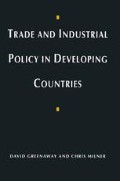Abstract
In Part I of this volume the role of trade policy in the process of economic development was emphasised. Parts II and III focused on empirical aspects of trade policy—the techniques of policy appraisal and their potential use in policy evaluation. In this part we take the analysis a stage further and examine how the techniques of policy appraisal have been used in the process of policy reform in LDCs. In recent years a major new source of conditional finance has emerged from The World Bank. As we shall see this has opened a window for substantial resources which can quickly be disbursed to LDCs. The disbursements are however conditional upon policy reforms being agreed and implemented. Many of the required policy reforms revolve around changes in trade policy.
Preview
Unable to display preview. Download preview PDF.
Author information
Authors and Affiliations
Copyright information
© 1993 David Greenaway and Chris Milner
About this chapter
Cite this chapter
Greenaway, D., Milner, C. (1993). Structural Adjustment Lending: Rationale and Trade Policy Aspects. In: Trade and Industrial Policy in Developing Countries. Palgrave Macmillan, London. https://doi.org/10.1007/978-1-349-22782-2_12
Download citation
DOI: https://doi.org/10.1007/978-1-349-22782-2_12
Publisher Name: Palgrave Macmillan, London
Print ISBN: 978-0-333-46920-0
Online ISBN: 978-1-349-22782-2
eBook Packages: Palgrave Economics & Finance CollectionEconomics and Finance (R0)

